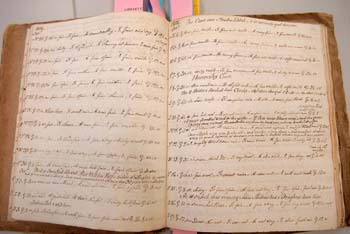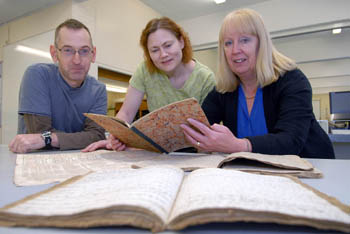19th Century Weather Diaries Shed Light On Climate Change


Climate change experts at Lancaster University have uncovered a rare record of 19th Century weather patterns in diaries belonging to a Gentleman Farmer from the North West.
The detailed diaries – dating back to 1815 before official Met Office weather records began – give a unique glimpse of climate and weather patterns in the region at the beginning of the industrial revolution.
‘Hail as large as eggs’, ‘deep snowdrifts’ and ‘sky as red as blood’ are all carefully documented in the series of well-preserved ‘weather books’ written around the time of the Battle of Waterloo.
Researchers investigating the documents have already discovered evidence that the effects of two early 19th Century Volcanic eruptions in Indonesia were being felt at the other side of the globe in the North West of England.
Christine Valentine, a Lab Technician in the department of Environmental Science, inherited a series of diaries and papers from one of her ancestors – a Gentleman farmer called John Andrew who lived in Hattersley, near Manchester.
Curious, observant and scientifically aware, Andrew kept a painstaking record of environmental observations, local gossip, farming news and – crucially - four daily weather reports throughout a substantial portion of his adult life. The surviving diaries cover the years 1815 to 1829 – a period when instrumental records were just beginning.
Over the years Mrs Valentine and her family have studied them as a social record but when she started working at the University alongside the Environmental Scientists interested in climate change she realised they could have further significance.
Dr Rob MacKenzie, Reader in Atmospheric Science at Lancaster University, said the rich detail and proven reliability of the information in the diaries meant they were an important new source of information from the decades before the start of standardised meteorological records.
“We are constantly trying to add regional detail to the historical climate record, and this is another piece of the jigsaw dating back to the beginning of the industrial revolution when both natural and man-made effects on the atmosphere were keenly felt.
“John Andrew obviously saw himself as a man of the Enlightenment – he was interested in many different areas of science such as maths and geology but he was clearly passionate about observing the climate.
“We have found tantalizing glimpses in there - references to things such as Moorgrime – we aren’t exactly sure what this is but there is one theory that it refers to the dirty, sooty deposits found on sheep’s wool in the morning. This would make sense given that he was farming so close to industrial centres in the North such as Manchester.”
Now, Lancaster university students Konstantina Lada and Deborah Lee have transferred the data in the diaries into a specially-created database which enables deeper analysis of changing weather patterns.
Ms Lee, a mature student who used to be a database designer, said the new database had enabled her to spot trends transforming the numerous diary entries into a rich source of quantifiable information.
One of her most interesting discoveries is that Andrew documented a change in the weather which could be linked to the major volcanic eruptions of 1815and 1822 in Indonesia – something which John Andrew would not have known about at the time.
“Through looking at his records we can see there a pattern emerging – Andrew records two long periods of unusual weather in 1816-17 and 1823. This is fascinating given that we now know that two major volcanic eruptions took place in Indonesia in the years immediately preceding each period of unusual weather.”
Mrs Valentine and the Environmental Science Department of the university are holding discussions with the National Meteorological Archive about how best to conserve the weather diaries, which are now very fragile and worn, and make the data in them available to the climate-change research community world-wide.
Mrs Valentine said: “I am just delighted that they are being put to such good use. When I found out about the work carried out here at Lancaster I thought they could be of value to staff and students. It’s wonderful to see they have attracted such interest.”
John Andrew is buried in the graveyard at Hyde Chapel and on his tomb is written:
“Beneath this stone is deposited the mortal part of John Andrew, Gentleman, late of Lumm, in Hattersley, who died 25th April 1837 in his 74th year. His attainments in natural, experimental and moral philosphy were various and profound. In all his researches he looked with humble piety through “Nature up to nature’s God”. He was a friend to civil and religious liberty, and a lover of the whole human race. His primitive manners and amiable virtues won for him the esteem of the public, and endeared him to a large circle of friends. Free from the bigot’s rage and stoic’s pride, calm as his life had been he calmly died. Also Mary, his wife, who died 6th August 1853, in her 87th year.”